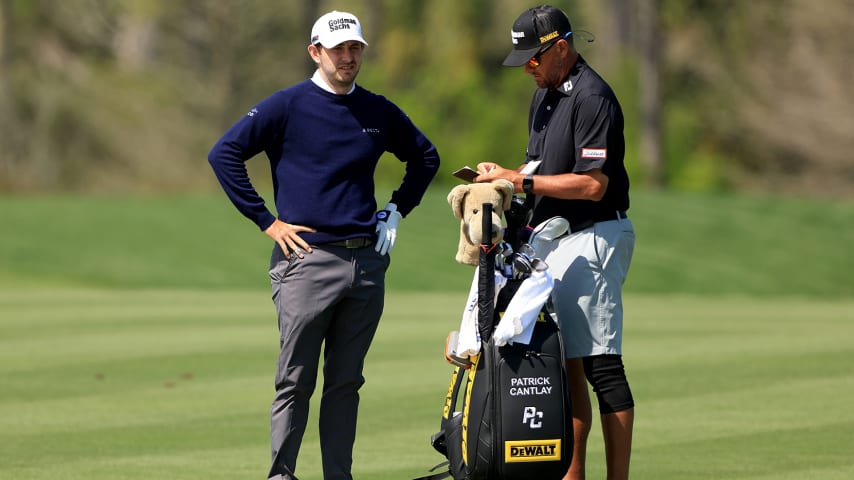Patrick Cantlay explains under-the-radar equipment changes
4 Min Read

Written by GolfWRX
Even the savviest of equipment aficionados may not have spotted Patrick Cantlay’s recent equipment experiments, but he’s been stealthily making impactful changes throughout the bag in 2023, searching for the right “feels” and greater precision.
As Cantlay admits, he’s not usually big into club testing. Case in point, even after becoming an equipment-free agent at the beginning of 2023, he’s still using the same golf club heads that he used in 2022 while under a club contract. In fact, he’s still using a Titleist TS3 driver that was released in 2018, and a Titleist 915F fairway wood from 2014. But, like most golfers in the modern game, Cantlay has worked on increasing his distances and speed, which has led him down a long road of shaft testing.

Patrick Cantlay has uses a Titleist TS3 driver that was released in 2018. (Richard Heathcote/Getty Images)
“In general, I’m not a big tester,” Cantlay said during a press conference at last week’s Arnold Palmer Invitational presented by Mastercard. “But if something’s better or potentially better, I’m now in a position (due to equipment free agency) where I can go out and put that [club] in right away. That’s exciting. I really have only done some shaft changes this year. I experimented with some stuff in the off-season and then at the beginning of this year.
“I have been swinging the golf club just a little bit faster lately, and that’s by design,” he continued. “I think it’s important to try and hit it farther these days. It’s just the simplest, fastest way to get a little better. So I noticed that the club, or the shaft, started to feel a little weak…I thought maybe going heavier [with all of my shafts] would help me hit it a little straighter.”
The danger of increasing speed is that it can come with a loss of control, often due to increased flexing and twisting of the shaft. In an attempt to solve the issue, Cantlay switched out his previous metal wood shafts for the versions that weigh 10 grams more. For example, instead of using a 60-gram Mitsubishi Diamana ZF driver shaft, he adopted the 70-gram version of the same model. With his irons, Cantlay switched from his previous 120-gram steel iron shafts (True Temper Dynamic Gold 120 Tour Issue X100) into iron shafts that weigh 10 grams more (True Temper Dynamic Gold Tour Issue X100).
He wasn’t changing the stiffness of his shafts, but was attempting to find a stiffer feel by adding weight. As he found out, however, this didn’t have the positive effect he thought it would.
“I tried to go heavier with everything from DG 120s to X100s and then just 10 grams heavier in the same wood shafts,” Cantlay said. “And the heavy change was really difficult for me to have similar feels.”
Drastic changes in feel are typically a nonstarter for PGA TOUR players, so it was back to the drawing board. Learning from his experiment, though, Cantlay went a different route that led to a more fitting solution.
“What I ended up doing was going back to the old weights, same shaft, and then tipping the wood shafts and hard-stepping the iron shafts,” Cantlay said. “That’s made a big difference in kind of just straightening out the ball flight, feeling like I don’t have to guard against too big of a draw. It’s been easy, much easier than going heavier as far as the feels go.”

Patrick Cantlay makes birdie at THE PLAYERS
Let’s explain two important shaft terms that Cantlay used:
1) “Hard-stepping” shafts is a method of re-shafting irons in such a way that it slightly increases stiffness throughout the set. Hard-stepping means that a golfer uses a 9-iron shaft in their 8-iron head, an 8-iron shaft in their 7-iron head, and so on, thus using slightly stiffer shafts in each iron
2) “Tipping” a wood shaft means that the golfer trims a portion from the tip section of the shaft (the part of the shaft that meets the club head), which effectively reduces torque and overall stiffness.
So, by rearranging his iron shafts and tip-trimming his wood shafts, Cantlay re-found his comfort zone and control, despite increasing his speed.
It seems the changes are already starting to set in, too. After finishing T16 at the Sentry Tournament of Champions, T26 at The American Express, and missing the cut at the WM Phoenix Open, Cantlay finished 3rd at The Genesis Invitational and T4 at the Arnold Palmer Invitational presented by Mastercard. He’s trending.
Cantlay is also debuting a new sponsor at THE PLAYERS Championship this week. While he started off the year with an all-black staff bag that was free of branding logos, he’s now using a black staff bag with yellow DeWalt branding – DeWalt manufactures power tools and hand tools.
Considering the shaft-trimming and club adjustments that Cantlay has made recently, the new sponsor makes sense.



